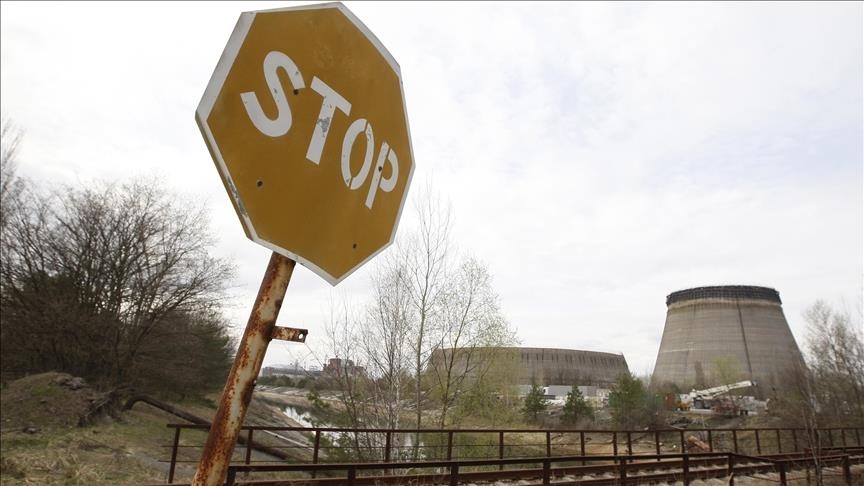Chernobyl nuclear disaster marks 36th anniversary amid Russia-Ukraine war
World's worst nuclear disaster took place on April 26, 1986 at Ukraine's Chernobyl nuclear power plant, which recently again came under Moscow's control

MOSCOW
The Chernobyl nuclear power plant, the site in 1986 of the world's worst nuclear disaster, this February came under the control of Russian forces for a time during the continuing war on Ukraine, on the eve of the accident’s 36th anniversary.
The accident took place on April 26, 1986 after a sudden surge of power during a reactor systems test and destroyed Unit 4 of the nuclear power station at Chernobyl, some 110 kilometers (68.3 miles) from Kyiv, capital of the then-Ukrainian Soviet Socialist Republic.
As many still remember the accident, its consequences continue to be discussed on the international stage.
The Chernobyl nuclear power plant was initially hailed as one of the greatest achievements of Soviet science.
In the catastrophic explosion – linked to inadequately trained personnel – a 2,000-ton roof blew up and eight tons of radioactive fuel were released into the atmosphere.
More than 30 firefighters were killed in the immediate aftermath of the accident, while millions more people were affected.
With the destroyed reactor continuing to emit lethal radiation, Soviet authorities did their best to cover up the incident.
According to the official numbers, roughly 8.4 million people in the former Soviet territories of Belarus, Russia, and Ukraine suffered the largest exposure to radiation in the form of a cloud.
An area of some 155,000 square km (60,000 square mi.) in these three countries was contaminated, and over 400,000 people were displaced.
Later research into the accident showed that the radioactive clouds reached as far as the US, Canada, and even Japan.
Fear of spreading radiation gripped many in Turkiye's Black Sea region, the area nearest Ukraine, but authorities assured the public that there was no cause for concern.
World Health Organization data stated that 600,000 people who lived, worked, and took part in disposal and cleaning operations in the 30-kilometer (18.6-mi.) zone of the disaster were exposed to high doses of radiation.
Around 5 million people in Belarus, Ukraine, and Russia still live in areas with a risk of radiation.
Trying to erase traces of disaster
Although decades have passed since the explosion at Chernobyl, efforts to erase the traces of the disaster still continue.
The building housing the Unit 4 reactor, center of the explosion in which the risk of spreading radiation continues, was completely covered with a special steel tent.
Official said radioactive fuels were scrubbed from the buildings, reducing the risk by a factor of 10,000. Efforts to rehabilitate the facility continue.
Researchers say that only 60% of the area around Chernobyl could be inhabitable after 60 years. However, even after the completion of isolation, liquidation and rehabilitation efforts, 40% of the region will still be off limits to settlement.
According to the International Atomic Energy Agency, 400 times more radiation than the atomic bomb dropped on Hiroshima was released into the atmosphere with the Chernobyl disaster.
The Ukrainian parliament decided to completely dismantle the Chernobyl nuclear power plant by 2065. Under this decision, in the first stage in 2010-2013, nuclear fuel was transported from power plants to warehouses.
In phase two, which began in 2013, the reactors were put under protection and the reactor where the accident took place was isolated.
As phase two is to end this year, in the third phase of 2022-2045, experts will observe the reduction of radiation after isolation.
The final stage of 2045-2065 will include dismantling and cleaning the power plant.

Russian troops entering Ukraine from Chernobyl caused concern
This Feb. 24, Ukraine said it lost control of the Chernobyl nuclear power plant in the country’s north after a fierce battle with Russian forces.
The Russian army, which took control of the power plant area without clashes, announced that they ensured security at the power plant together with Ukrainian soldiers.
Russia further claimed that Ukrainian nationalist forces could provoke provocation at the power plant, while Ukraine accused Russian forces of shelling the plant, saying this could lead to another nuclear disaster.
Press reports also said Russian soldiers seems ill-prepared to deal with the plant and its many dangers.
On March 9, Ukraine said the electricity grid feeding the plant and all the nuclear facilities around was damaged and called for an immediate cease-fire to fix the malfunction.
Only 48-hour backup generators were turned on at the power plant, which faced the risk of the cooling system not working. Soon thereafter Russia’s Energy Ministry announced that electricity had been restored to the power plant via Belarus. Ukraine's Energy Ministry also reported that repairs had been completed.
Following negotiations held between Russia and Ukraine in Istanbul, Moscow announced a decision to withdraw its troops from Kyiv and Chernihiv on March 30.
Thereafter Russian soldiers also withdrew from the Chernobyl nuclear power plant.
At least 2,665 civilians have been killed and 3,053 injured in Ukraine since Russia launched a war on Ukraine on Feb. 24, according to UN estimates, with the true figure feared to be much higher.
More than 5.2 million Ukrainians have fled to neighboring countries, according to the UN refugee agency.
Anadolu Agency website contains only a portion of the news stories offered to subscribers in the AA News Broadcasting System (HAS), and in summarized form. Please contact us for subscription options.







